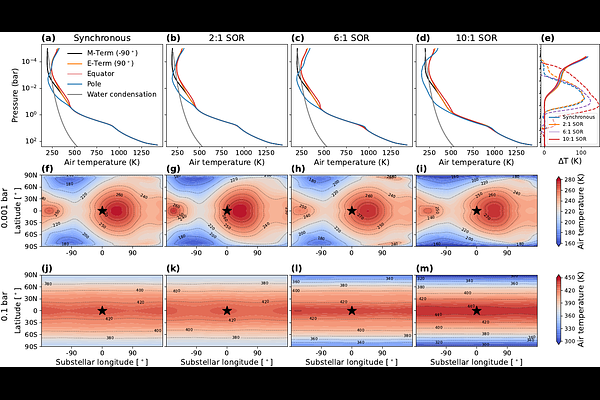Three-dimensional Transport-induced Chemistry on Temperate sub-Neptune K2-18b, Part I: the Effects of Atmospheric Dynamics

Three-dimensional Transport-induced Chemistry on Temperate sub-Neptune K2-18b, Part I: the Effects of Atmospheric Dynamics
Jiachen Liu, Duncan Christie, Jun Yang
AbstractThe low equilibrium temperatures of temperate sub-Neptunes lead to extremely long chemical timescales in their upper atmospheres, causing the abundances of chemical species to be strongly shaped by atmospheric transport. Here, we used a three-dimensional (3D) general circulation model involving a passive tracer to investigate the atmospheric circulation and 3D transport of temperate gas-rich sub-Neptunes, using K2-18b as an example. We model K2-18b as a synchronous or asynchronous rotator, exploring spin-orbit resonances (SOR) of 2:1, 6:1, and 10:1. We find that the strong absorption of CO$_2$ and CH$_4$ induces a detached convective zone between 1 and 5 bar, resulting in strong vertical mixing at these levels. The upper atmosphere is dominated by eastward winds (an equatorial superrotating jet present in all simulations), leading to warmer evening terminators and approximately 20% higher passive tracer mass mixing ratios compared to the morning terminators. Rotation rates have minimal impact on the strength of global mean vertical mixing, but significantly influence the latitudinal distribution of passive tracers. For synchronous, 2:1 SOR, and 6:1 SOR simulations, passive tracers are more abundant in the upwelling branches at latitudes within 60$^\circ$, while for the 10:1 SOR simulation, strong transient eddies at high latitudes (>70$^\circ$) between 0.1 to 1 bar can transport passive tracers upward from the deep atmosphere, making them more abundant there, despite their alignment with the downwelling branch of the large-scale circulation. This study focuses on the atmospheric dynamics and its influence on passive tracer transport, while a follow-up paper will incorporate active chemical species.